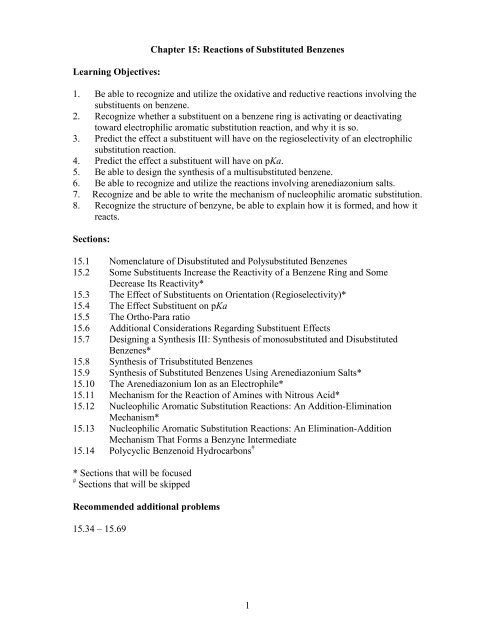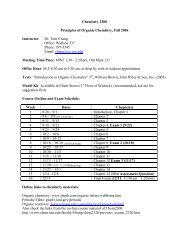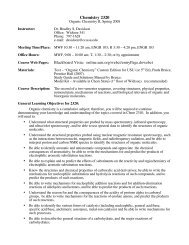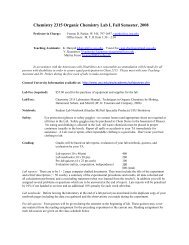1 Chapter 15: Reactions of Substituted Benzenes Learning ...
1 Chapter 15: Reactions of Substituted Benzenes Learning ...
1 Chapter 15: Reactions of Substituted Benzenes Learning ...
You also want an ePaper? Increase the reach of your titles
YUMPU automatically turns print PDFs into web optimized ePapers that Google loves.
<strong>15</strong>.2 Some Substituents Increase the Reactivity <strong>of</strong> a Benzene Ring and SomeDecrease Its Reactivity* and <strong>15</strong>.3 The Effect <strong>of</strong> Substituents on Orientation(Regioselectivity)*electron donation group (EDG)electron withdrawing group (EWG)EDGEWGA. Relative rate <strong>of</strong> electrophilic aromatic substitutionExamples:OCH 3 NO 2• Rate-determining step (r.d.s)• Resonance effect and inductive effect3
B. Relative reactivity and regioselectivity <strong>of</strong> substituted benzenesStrong activating groups (substituents)NH 2OH ORModerate activating groups (substituents)OOHNROR4
Weak activating groups (substituents)RWeak deactivating groups (substituents)F Cl Br I5
Moderate deactivating groups (substituents)O H O R O OR OHNR6
Strong deactivating groups (substituents)SO 3 H NO 2 CN NR 37
(iii)BrCl 2 , FeCl 3(iv)ORBr 2 (1 equivalent)FeCl 3ORBr 2 (excess)FeCl 39
(v)NH 2CH 3 COClAlCl 3OHNRCH 3 COClAlCl 3(vi)ORNO 2HNO 3H 2 SO 4HNO 3H 2 SO 410
(vii) Synthesis <strong>of</strong> trinitrotolueneCH 3HNO 3H 2 SO 411
<strong>15</strong>.4 The Effect Substituent on pKaI II III IV V VIOHOHOHOHOHOHOCH 3CH 3ClCHONO 2I II III IV V VICO CO 2 HCO 2 HCO 2 H2 HCO 2 HCO 2 HOCH 3CH 3BrCHONO 2IIIIIINH 3NH 3NH 3IV V VINH 3NH 3OCH CHCHO3 3BrNH 3NO 212
<strong>15</strong>.7 Designing a Synthesis III: Synthesis <strong>of</strong> monosubstituted and Disubstituted<strong>Benzenes</strong>* and <strong>15</strong>.8 Synthesis <strong>of</strong> Trisubstituted <strong>Benzenes</strong>Design multiple-step synthesis:* Selectivity: chemoselectivity, regioselectivity, and stereoselectivity* Retrosynthetic analysis: breaking and formation <strong>of</strong> chemical bonds13
A. Examples(i)OHfrom14
(ii)OCH 3fromO 2 N(iii)OCH 3fromNO 2<strong>15</strong>
<strong>15</strong>.9 Synthesis <strong>of</strong> <strong>Substituted</strong> <strong>Benzenes</strong> Using Arenediazonium Salts and <strong>15</strong>.11Mechanism for the Reaction <strong>of</strong> Amines with Nitrous Acid*A. Formation <strong>of</strong> diazonium saltR NH 20 o CNaNO 2 , HClR N N Cldiazonium saltMechanism:16
B. Reaction <strong>of</strong> arenediazonium salt with nucleophilesSandmeyer reation (CuBr, CuCl, and CuCN)Reaction with KI, HBF 4 , H 3 O + , and H 3 PO 217
<strong>15</strong>.10 The Arenediazonium Ion as an Electrophile*NNNu* Nucleophile better be bulky* Terminal nitrogen reacts with nucleophile18
<strong>15</strong>.12 Nucleophilic Aromatic Substitution <strong>Reactions</strong> (S N Ar): An Addition-EliminationMechanism*A. Comparison <strong>of</strong> S N Ar, S N 1, and S N 2B. General mechanism19
C. Examples(i)ClOHOHNO 2NO 2ClOHO 2 NNO 2NO 2ClNO 2NO 2OHOHO 2 NNO 2NO 2OHNO 2NO 2(ii)BrNHCH 2 CH 3NO 2 NO 2CH 3 CH 2 NH 2then OHNO 2 NO 220
<strong>15</strong>.13 Nucleophilic Aromatic Substitution <strong>Reactions</strong>: An Elimination-AdditionMechanism That Forms a Benzyne Intermediate21
















